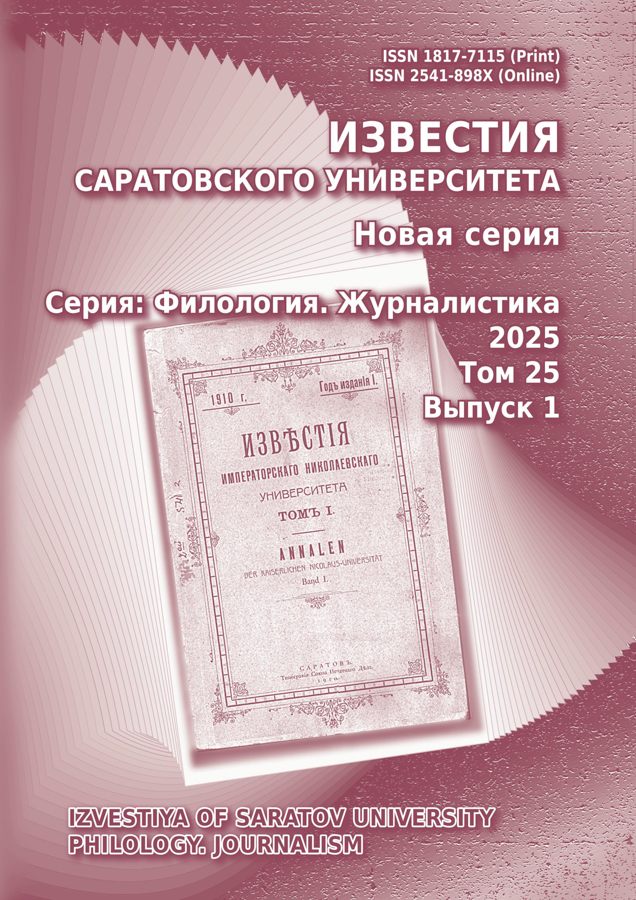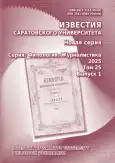News of Saratov University. Ser. Philology
ISSN (print): 1817-7115, ISSN (online): 2541-898X
Founder: Saratov State University
Editor-in-Chief: Prozorov Valery Vladimirovich, Doctor of Philology. sciences, professor
Frequency / Access: 4 issues per year / Open
Included in: Higher Attestation Commission List, RISC
The journal is registered in the Federal Service for the Supervision of Communications, Information Technology, and Mass Media (Roskomnadzor).
Registration PI № FS77-76639 of 26 August, 2019.
Subject-matter of the Journal: language theory, comparative and historic linguistics, speech communication, discursive practices, the Russian language and speech culture, Russian as a foreign language, Romance and Germanic languages and translation studies, dialectology, cognitive linguistics, psycholinguistics, sociolinguistics, applied linguistics, theory of literature, folklore, history of the Russian and foreign (British-American and French) literature, modern literary process, text studies, poetics, comparative literary studies, literary criticism, literary studies of local lore, history and theory of journalism, mass communications in information society, language of mass media.
Correspondence of the Journal sections to the List of scientific disciplines in which Candidate and Doctorate academic degrees are conferred:
5.9.1. Russian literature and literatures of the peoples of the Russian Federation (philological sciences),
5.9.2. World Literature (philological sciences),
5.9.5. The Russian language. Languages of the peoples of Russia (philological sciences),
5.9.6. Foreign Languages (Germanic and Romance languages) (philological sciences),
5.9.8. Theoretical, applied, comparative and contrastive linguistics (philological sciences),
5.9.9. Media communications and journalism (philological sciences).
The archive list of qualifications available until 16 October 2022:
10.01.01 – Russian literature
10.01.03 – Literature of the people of foreign countries (English, American, French, German)
10.01.10 – Journalism
10.02.01 – Russian language
10.02.04 – Germanic languages
10.02.05 – Romance languages
10.02.19 – Language theory.
Aims and Scope
The Journal’s main aim is to promptly inform the humanitarian community of the results of current research in the spheres of linguistics, literary studies and journalism, which promote the development of science and education.
Journal’s objectives are:
- to publish authentic scientific papers in theoretic and applied linguistics, Russian, Germanic and Romance languages, history and theory of literature, media studies and media didactics;
- to discuss current issues of the philological science;
- to unify the research efforts aimed at a complex exploration of relevant issues of general humanities;
- to address up-to-date controversial issues of higher philological and journalist education;
- to promptly inform about significant scientific events and philologically-targeted publications.
The Journal targets specialists in linguistics, literary studies, journalism and other humanities’ scientists (researchers, university teachers, graduate students, students).
Procedure for manuscript selection and publication. Manuscripts containing original material are accepted for publication unless they have been previously published elsewhere or have been accepted for consideration by other journals, in the spheres of Linguistics, Literary Studies, Journalism, as well as materials for the sections Criticism and bibliography, Chronicles of scientific life.
Current Issue
Vol 25, No 1 (2025)
Linguistics
Complexity as a textual, linguistic and metalinguistic category
Abstract
 1-14
1-14


Variability of the genre of autobiographical story in dialect and literary-colloquial speech (on the material of Saratov dialectological corpus)
Abstract
 15-23
15-23


Spouses addressing their parents-in-law in Russian culture
Abstract
 24-33
24-33


Special features speech portrait of an autistic child in Mark Haddon’s novel The Curious Incident of the Dog in the Night-Time translated into Russian
Abstract
The article deals with the issue of studying the speech characteristics of a literary character, which is no doubt of significant interest. The speech portrait of a literary character is one of the key components in forming an image in a literary text. However, the speech of child char acters, especially those with developmental disorders, has not received much attention. The source material for the study is the modern novel The Curious Incident of the Dog in the Night-Time (2003) by Mark Haddon and its translation into Russian made by A. Kukley (2003). The paper’s main purpose is to enumerate, classify, and analyze the complex speech portrait of a child with an autism spectrum disorder and to examine the methods used for translating these characteristics. The study draws upon the classification that focuses on the impairments in socialization, communication, and imagination, which are central to autism research. The author’s methodology, based on the use of the continuous sampling method, classification method, comparative analysis method, and quantitative method, allowed to reach some conclusions and observations. The author claims that the majority of the speech characteristics typical of a teenager with autism are preserved in the translated text. According to the author, the translator carefully conveys these characteristics into another language, sometimes making changes considering the context, nuances of a language structure, and cultural differences, which requires certain adaptations in order to render meaning and emotions more precisely.
 34-39
34-39


Interaction between religious, historical and literary discourses in mass media
Abstract
 40-46
40-46


Synchronous-diachronic analysis of the thematic group “Supernatural beings in religious cultures” (on the material of the Russian language)
Abstract
 47-56
47-56


Literary Criticism
Cypress by a cave: Erotic frustration, agon and death in Theocritus’ Idyll XI
Abstract
 57-66
57-66


The tale “Sleeping Beauty” by Ch. Perrault in the mirror of libretto by I. A. Vsevolozhsky and M. Petipa
Abstract
 67-75
67-75


Z. N. Gippius’s letters in diary discourse of S. P. Kablukov
Abstract
 76-84
76-84


Insect symbolism in the oeuvre of B. Poplavsky: Cicadas and grasshoppers
Abstract
 85-91
85-91


Tragic dialectics of the lives of children from Tiverzin’s yard in the novel Doctor Zhivago by B. L. Pasternak
Abstract
 92-98
92-98


The infl uence of Russian satire on Dungan satirical prose in Central Asia
Abstract
 99-103
99-103


The folklore and mythological basis of the women’s quest in the Russian-language fantasy novel: To the statement of the problem
Abstract
 104-109
104-109


Journalism
The culture of journalists’ speech in the period of mediatization of communication
Abstract
 110-116
110-116


Chronicle of Scholarly Activities
22nd International scientific conference “Onomastics of the Volga region”
Abstract
 117-120
117-120












